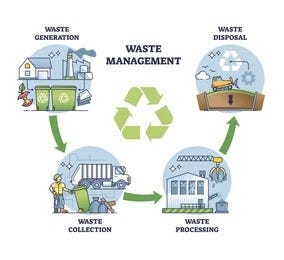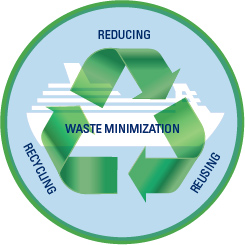Recycling Lives Services: Leading the Way in Accountable Recycling
Recycling Lives Services: Leading the Way in Accountable Recycling
Blog Article
Discovering Various Types of Waste in Modern Waste Monitoring Equipment
The contemporary landscape of waste management entails browsing a complicated array of waste types, each calling for specialized handling and disposal approaches to minimize ecological impacts. Metropolitan solid waste, unsafe waste, digital waste, and organic waste each existing unique challenges and chances for resource healing.
Local Strong Waste
Municipal solid waste, often described as house trash or rubbish, incorporates a range of discarded materials produced by residential, industrial, and institutional sources within a district. This waste stream commonly consists of products such as packaging, food scraps, yard trimmings, paper, plastics, textiles, and thrown out family products. The monitoring of local strong waste is a critical part of city preparation and public wellness, necessitating reliable collection, transportation, and disposal systems.
Effective waste monitoring systems are made to lessen environmental effect while making the most of source recovery. This often includes a combination of methods consisting of recycling, landfilling, and composting. Reusing programs target materials like paper, glass, metals, and particular plastics, diverting them from landfills and reestablishing them into the manufacturing cycle. Composting natural waste, such as food scraps and yard trimmings, not only minimizes landfill usage yet additionally produces useful dirt amendments.
Municipalities need to additionally resolve the logistical and financial challenges connected with waste administration. Applying pay-as-you-throw systems, boosting public recognition, and purchasing innovation can dramatically boost waste diversion prices. By incorporating these practices, municipalities can cultivate lasting areas, minimize greenhouse gas exhausts, and save natural deposits.
Hazardous Waste

Effective contaminated materials monitoring includes numerous vital actions: recognition, partition, treatment, and disposal. Identification involves the category of waste based on its hazardous residential or commercial properties. Partition guarantees that harmful products are kept separately from non-hazardous waste to stop cross-contamination. Therapy methods, such as chemical neutralization, incineration, and stabilization, are utilized to reduce the poisoning, volume, or mobility of the waste. Disposal options, including safe land fills and below ground storage space, are picked to ensure long-lasting containment.
Regulatory structures, such as the Source Preservation and Recuperation Act (RCRA) in the USA, give standards and criteria for unsafe waste administration. Adherence to these guidelines, combined with improvements in waste treatment technologies, is important in mitigating the dangers connected with contaminated materials.
Digital Waste
Electronic waste, commonly described as e-waste, stands for a swiftly expanding challenge in waste management systems around the world. This kind of waste incorporates disposed of electronic tools and equipment such as smartphones, computer systems, televisions, and various other electronic appliances. The rapid rate of technological advancement, coupled with lowering product life-spans and consumer need for the most recent tools, has actually greatly boosted the quantity of e-waste generated yearly.
E-waste is particularly problematic because of its intricate structure, frequently consisting of unsafe compounds like cadmium, mercury, and lead, which pose considerable ecological and health risks otherwise properly handled. Alternatively, e-waste additionally consists of important materials such as gold, copper, and silver, which can be recuperated and reused. The twin nature of e-waste-- both valuable and hazardous-- requires customized handling, recycling, and disposal processes.
Efficient e-waste monitoring entails rigorous governing frameworks, robust collection systems, and progressed reusing innovations. Public recognition and participation are essential, as browse around this web-site incorrect disposal techniques, such as illegal disposing and informal recycling, intensify environmental contamination and health and wellness dangers. Subsequently, boosting e-waste monitoring techniques is vital for reducing environmental effect and recuperating useful resources in a progressively electronic globe.

Organic Waste
Organic waste, making up kitchen scraps, backyard trimmings, and farming residues, represents a substantial section of the worldwide waste stream. This kind of waste is naturally degradable, implying it can be broken down by microbes into easier natural compounds. In spite of its possibility for natural disintegration, improper management of natural waste can result in damaging environmental effects, consisting of the emission of greenhouse gases such as methane, which add to climate modification.
Reliable management of natural waste is crucial for lessening these ecological impacts (recycling lives services). Composting is a commonly site here taken on technique, transforming organic waste right into nutrient-rich garden compost that can enhance dirt health and farming efficiency. Furthermore, anaerobic food digestion is an arising innovation that transforms natural waste right into biogas, a renewable resource source, and digestate, which can be made use of as fertilizer
Municipalities and waste management entities must carry out durable organic waste collection and treatment programs to optimize the benefits of these processes. Public education campaigns can likewise play a crucial role in encouraging households and businesses to different organic waste from various other sorts of waste. By focusing on the management of organic waste, societies can decrease land fill usage, lower greenhouse gas discharges, and produce useful byproducts for agricultural usage.

Cutting-edge Waste Administration
In the realm of waste monitoring, innovative methodologies are transforming exactly how cultures handle their refuse, intending for sustainability and performance. One famous advancement is the implementation of smart waste bins equipped with sensing units that check fill levels and enhance collection paths.
Another remarkable growth is the adoption of waste-to-energy (WtE) technologies. By converting non-recyclable waste right into functional energy through procedures such as incineration and anaerobic food digestion, WtE reduces garbage dump problem and gives a sustainable energy resource. Furthermore, innovations in chemical recycling permit the malfunction of complicated plastics into their initial monomers, enabling the production of new, premium plastic products.
In addition, the circular economy design is obtaining traction, stressing the design of products and systems that focus on reusability and resource performance. This holistic method urges sectors to reduce waste generation from the outset. Through these innovative techniques, modern waste administration systems are not only addressing the instant challenges of garbage disposal yet also leading the way for a more sustainable future.
Conclusion
An extensive understanding of metropolitan solid waste, harmful waste, digital waste, and organic waste, check that paired with the implementation of innovative waste management options, is important for minimizing environmental impacts. Integrating innovations such as wise waste containers and waste-to-energy systems can boost effectiveness and sustainability. Effective waste management strategies not only foster resource healing however likewise advertise public understanding and involvement, inevitably contributing to the development of a circular economic climate.
The contemporary landscape of waste management involves browsing a complex array of waste types, each calling for specialized handling and disposal approaches to reduce environmental impacts. Municipal solid waste, unsafe waste, digital waste, and natural waste each existing unique difficulties and chances for resource recovery.Electronic waste, frequently referred to as e-waste, represents a quickly growing challenge in waste administration systems around the world. With these ingenious strategies, modern-day waste management systems are not just attending to the immediate challenges of waste disposal yet likewise leading the way for a much more lasting future.
A comprehensive understanding of metropolitan solid waste, dangerous waste, digital waste, and natural waste, coupled with the execution of ingenious waste administration options, is critical for minimizing environmental influences. (recycling lives services)
Report this page